Abstract
Although muscle is considered to be the most important site for postprandial glucose disposal, the metabolic fate of oral glucose taken up by muscle remains unclear. We, therefore, employed the dual isotope technique (intravenous, [6-3H]-glucose; oral, [1-14C]glucose), indirect calorimetry, and forearm balance measurements of glucose, lactate, alanine, pyruvate, O2, and CO2 in nine normal volunteers to determine the relative importance of muscle glycogenic, glycolytic, and oxidative pathways in disposal of an oral glucose load. During the 5 h after glucose ingestion (1 g/kg), 37 +/- 3% (24.9 +/- 2.3 g) of the load was oxidized and 63 +/- 3% (42.8 +/- 2.7 g) was stored. At least 29% (19.4 +/- 1.3 g) was taken up by splanchnic tissues. Muscle took up 26% (17.9 +/- 2.9 g) of the oral glucose coincident with a 50% reduction in its oxidation of fat. 15% of the oral glucose taken up by muscle (2.5 +/- 0.9 g) was released as lactate, alanine, or pyruvate; 50% (8.9 +/- 1.4 g) was oxidized, and 35% (6.4 +/- 2.3 g) was available for storage. We conclude that muscle and splanchnic tissues take up a comparable percentage of an oral glucose load and that oxidation is the predominant fate of glucose taken up by muscle, with storage in muscle accounting for less than 10% of the oral load. Thus, contrary to the prevailing view, muscle is neither the major site of storage nor the predominant site of disposal of an oral glucose load.
Full text
PDF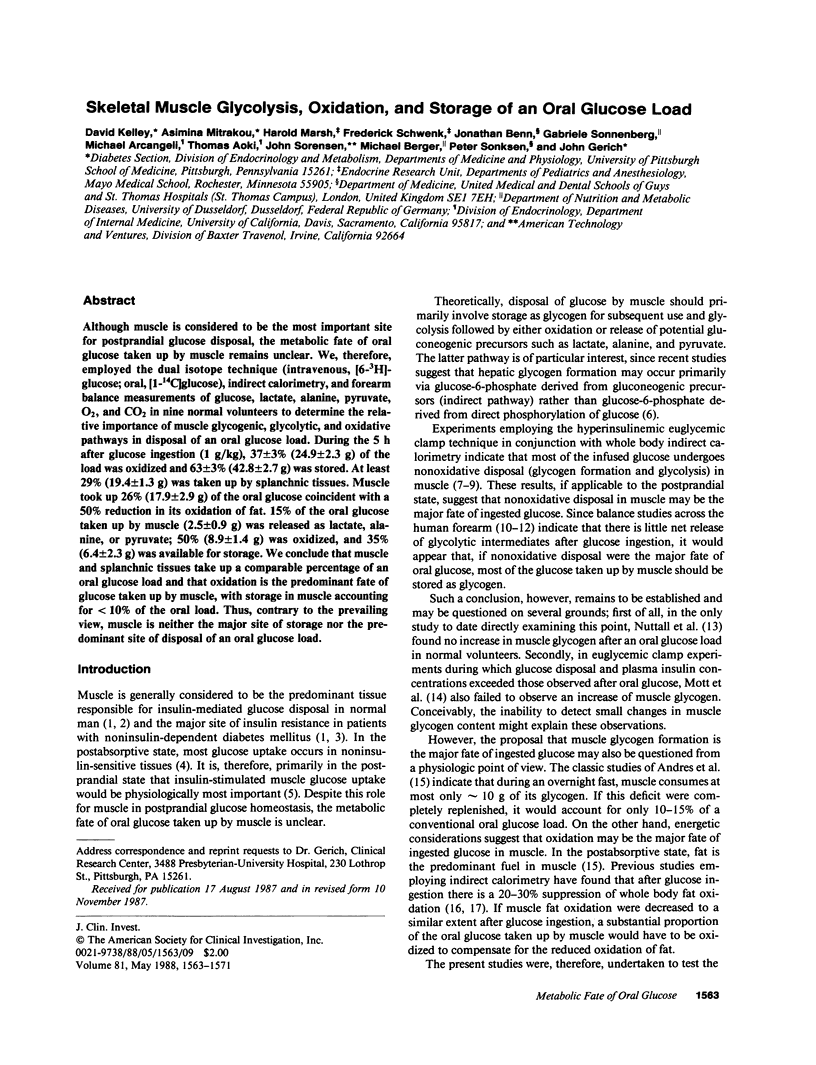
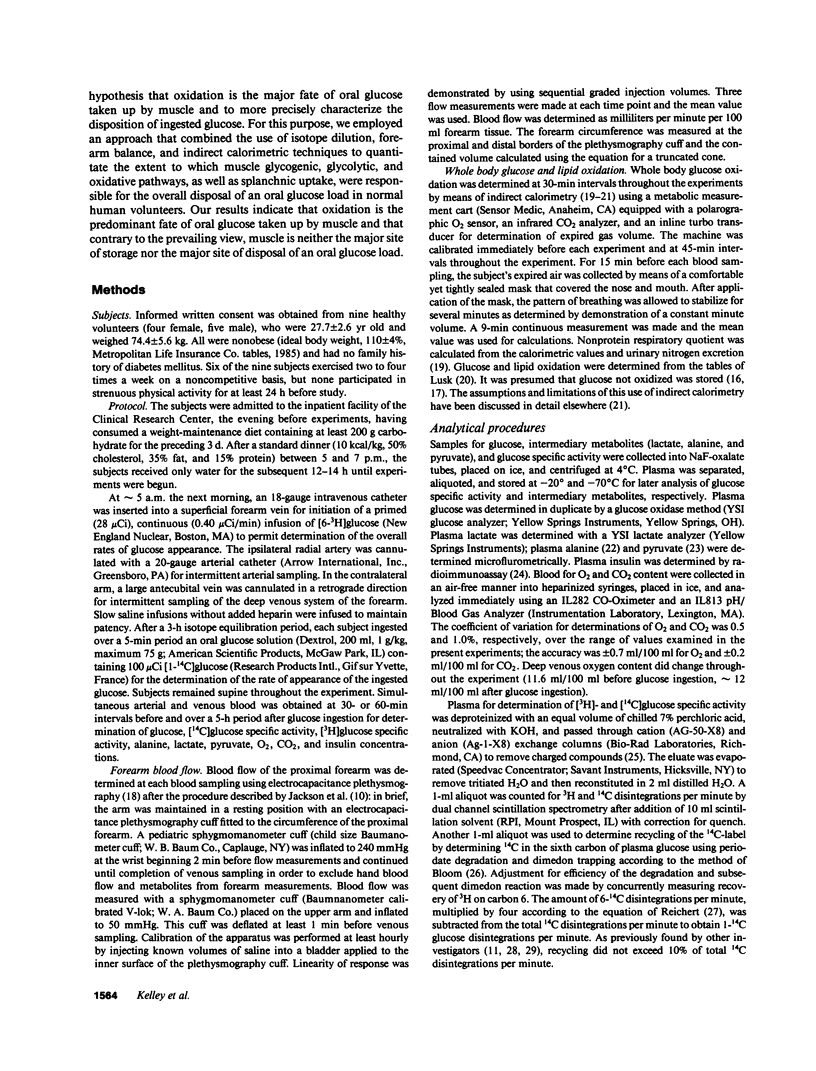
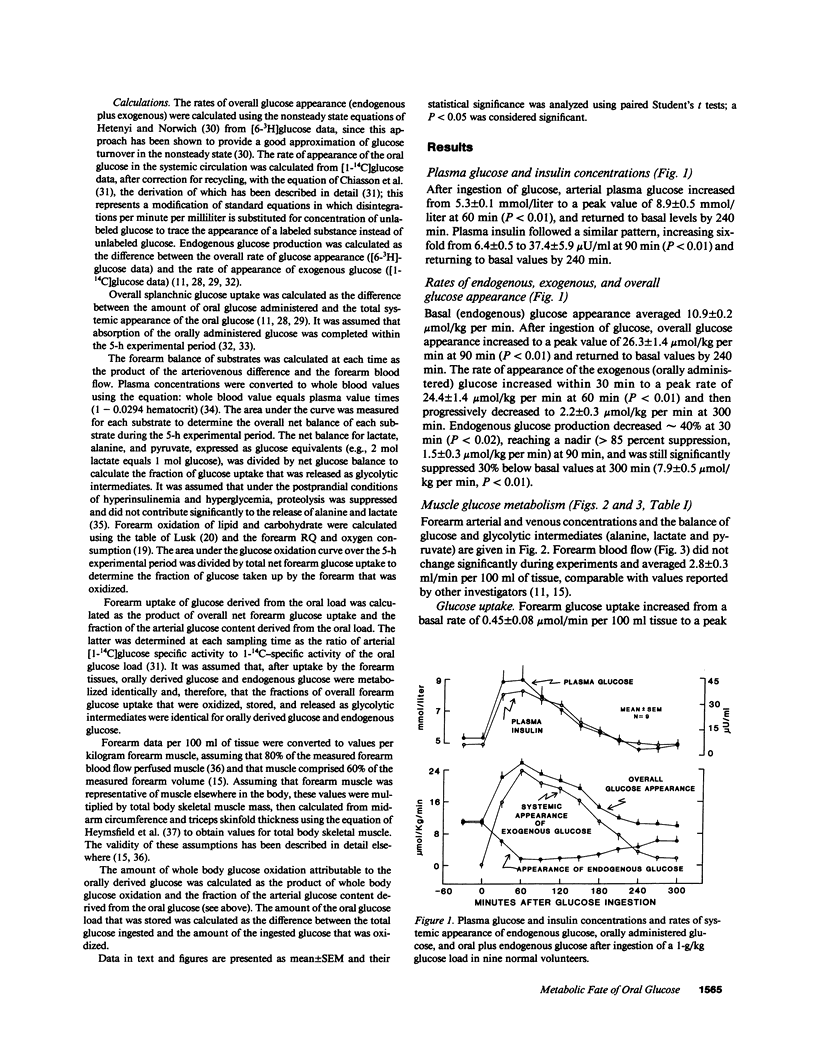
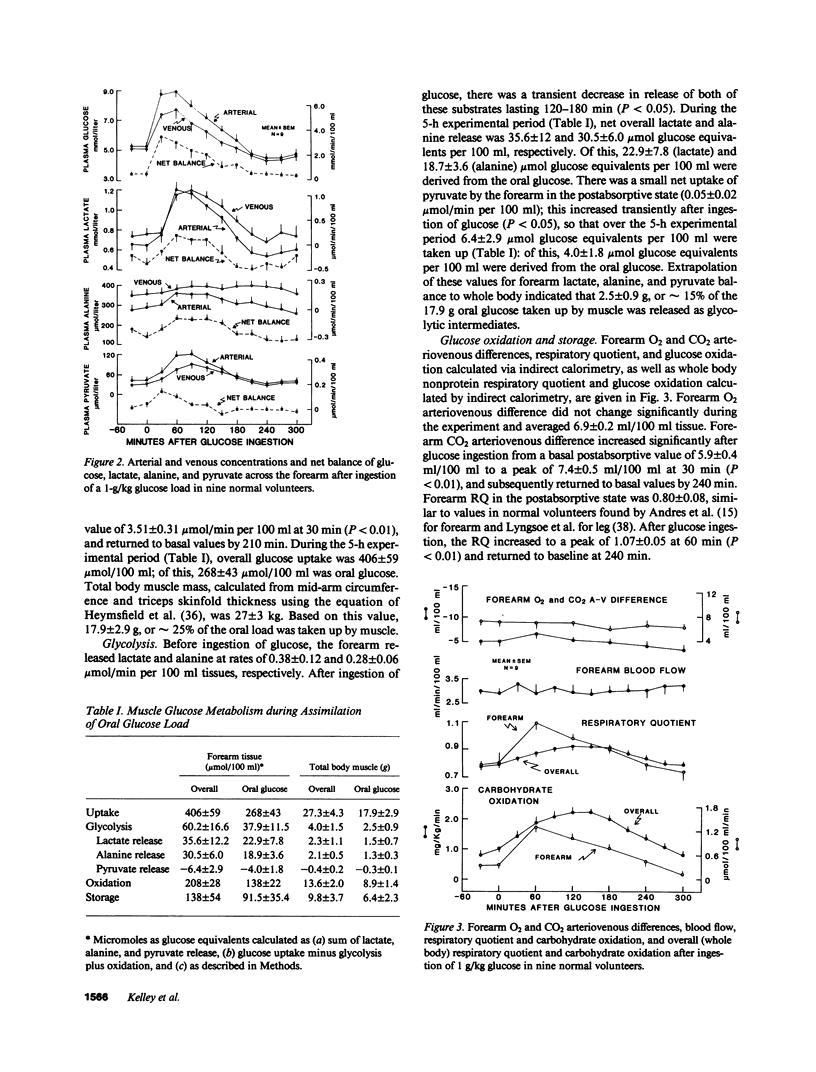
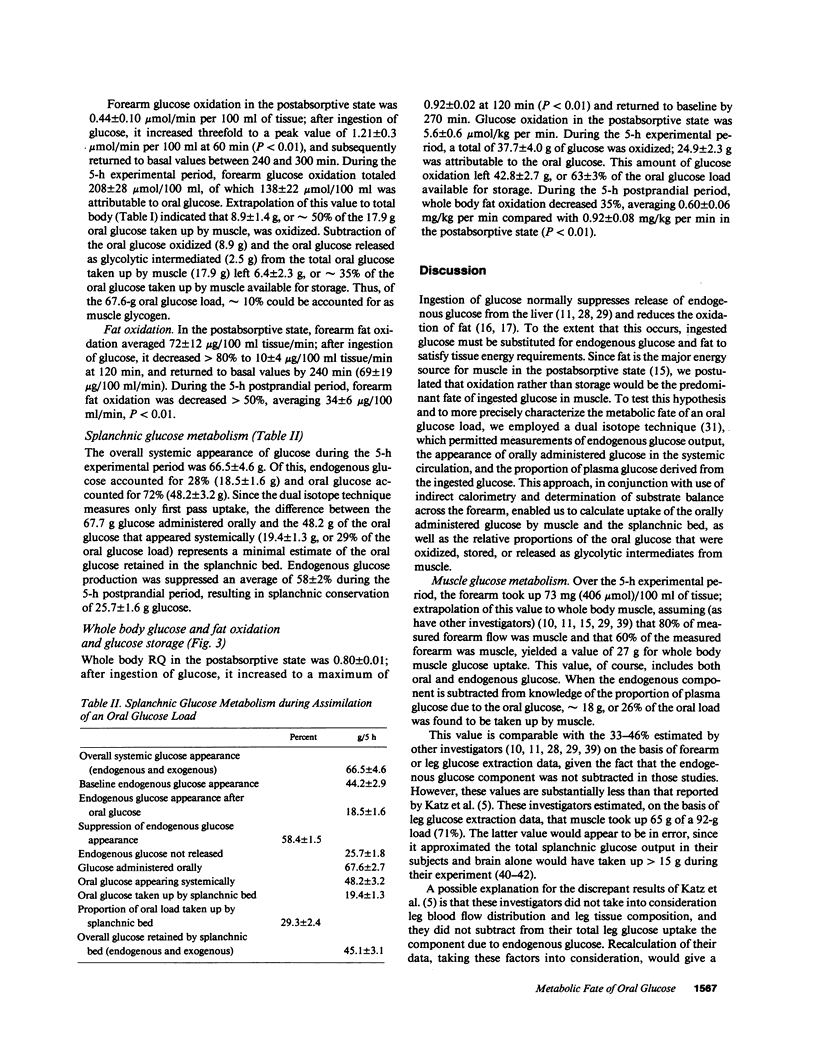
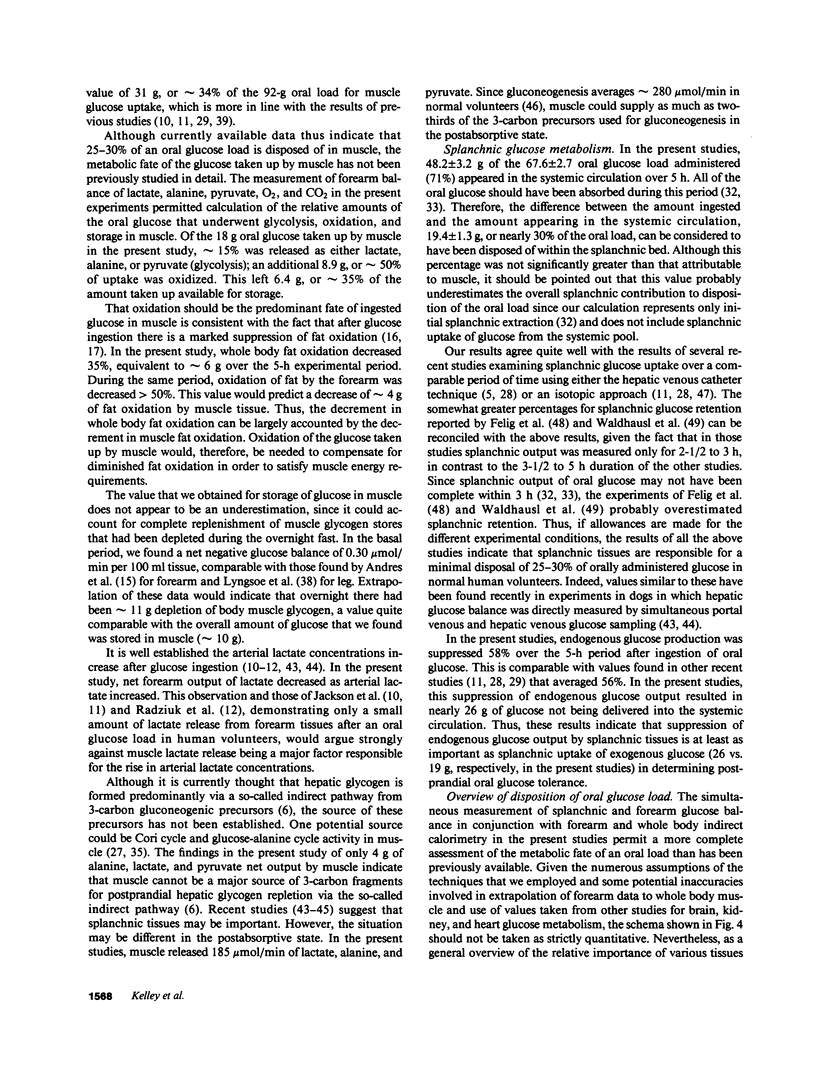
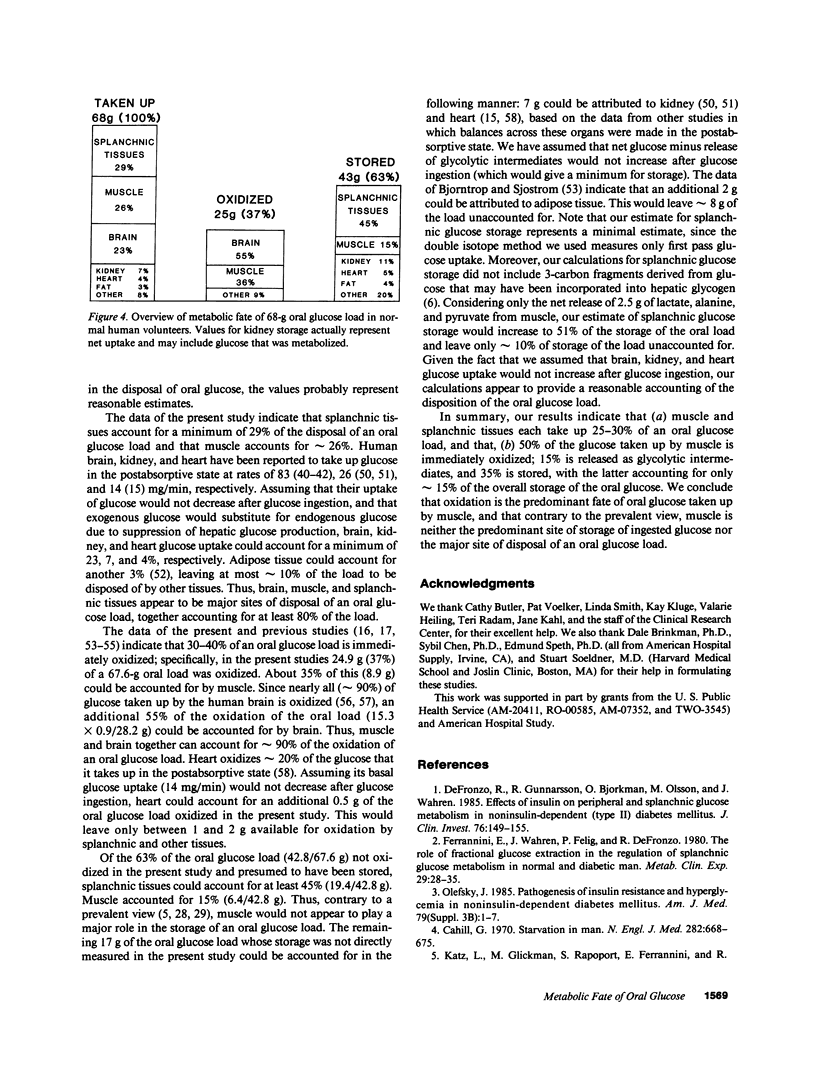
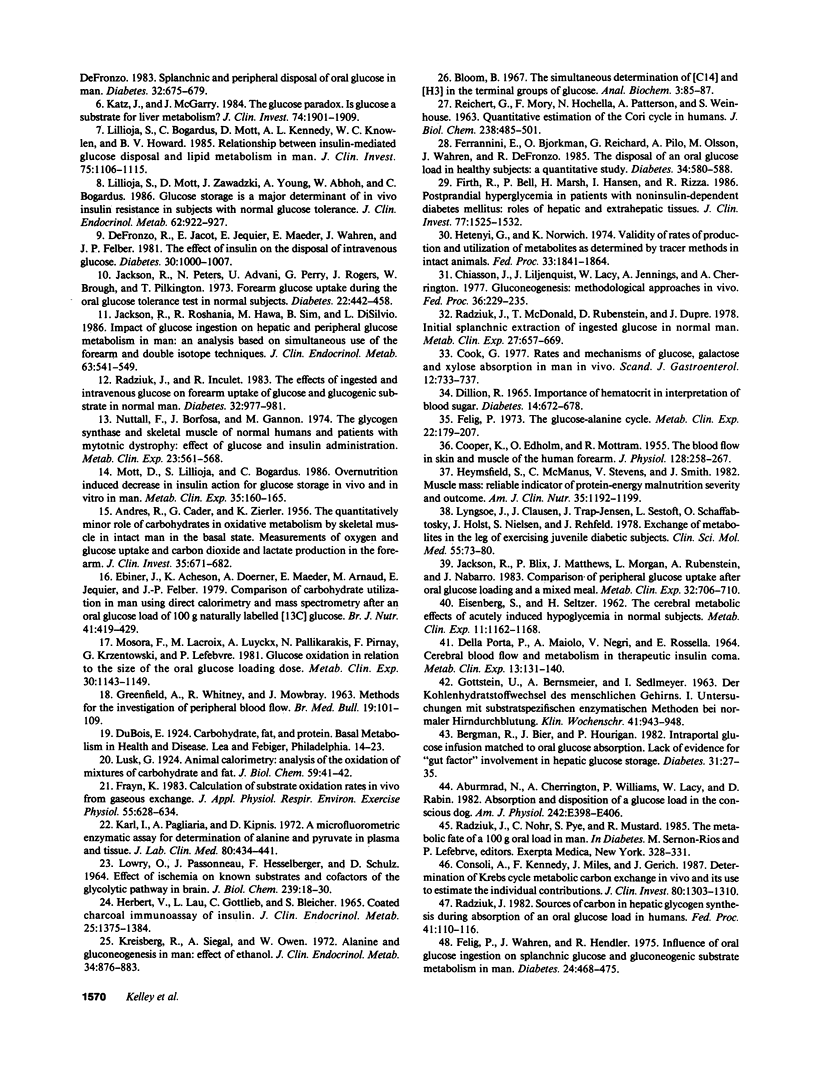
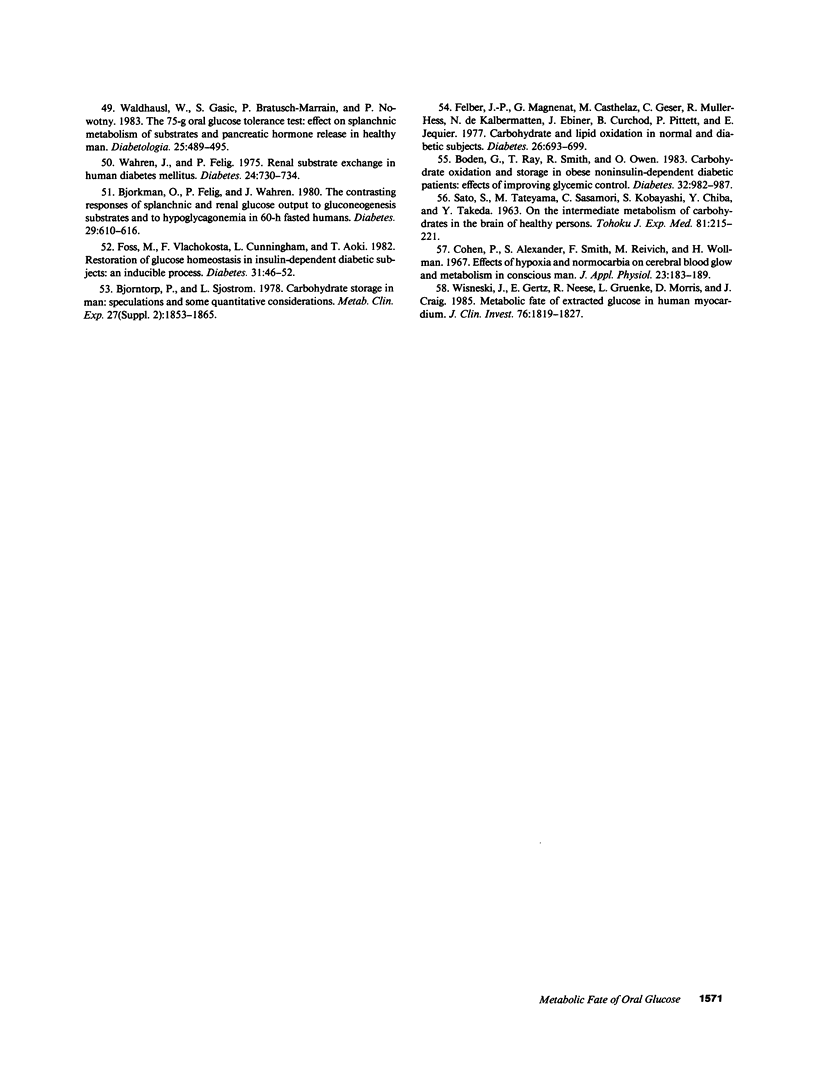
Selected References
These references are in PubMed. This may not be the complete list of references from this article.
- ANDRES R., CADER G., ZIERLER K. L. The quantitatively minor role of carbohydrate in oxidative metabolism by skeletal muscle in intact man in the basal state; measurements of oxygen and glucose uptake and carbon dioxide and lactate production in the forearm. J Clin Invest. 1956 Jun;35(6):671–682. doi: 10.1172/JCI103324. [DOI] [PMC free article] [PubMed] [Google Scholar]
- Abumrad N. N., Cherrington A. D., Williams P. E., Lacy W. W., Rabin D. Absorption and disposition of a glucose load in the conscious dog. Am J Physiol. 1982 Jun;242(6):E398–E406. doi: 10.1152/ajpendo.1982.242.6.E398. [DOI] [PubMed] [Google Scholar]
- BLOOM B. The simultaneous determination of C14 and H3 in the terminal groups of glucose. Anal Biochem. 1962 Jan;3:85–87. doi: 10.1016/0003-2697(62)90048-9. [DOI] [PubMed] [Google Scholar]
- Bergman R. N., Beir J. R., Hourigan P. M. Intraportal glucose infusion matched to oral glucose absorption. Lack of evidence for "gut factor" involvement in hepatic glucose storage. Diabetes. 1982 Jan;31(1):27–35. doi: 10.2337/diab.31.1.27. [DOI] [PubMed] [Google Scholar]
- Björkman O., Felig P., Wahren J. The contrasting responses of splanchnic and renal glucose output to gluconeogenic substrates and to hypoglucagonemia in 60-h-fasted humans. Diabetes. 1980 Aug;29(8):610–616. doi: 10.2337/diab.29.8.610. [DOI] [PubMed] [Google Scholar]
- Björntorp P., Sjöström L. Carbohydrate storage in man: speculations and some quantitative considerations. Metabolism. 1978 Dec;27(12 Suppl 2):1853–1865. doi: 10.1016/s0026-0495(78)80004-3. [DOI] [PubMed] [Google Scholar]
- Boden G., Ray T. K., Smith R. H., Owen O. E. Carbohydrate oxidation and storage in obese non-insulin-dependent diabetic patients. Effects of improving glycemic control. Diabetes. 1983 Nov;32(11):982–987. doi: 10.2337/diab.32.11.982. [DOI] [PubMed] [Google Scholar]
- COOPER K. E., EDHOLM O. G., MOTTRAM R. F. The blood flow in skin and muscle of the human forearm. J Physiol. 1955 May 27;128(2):258–267. doi: 10.1113/jphysiol.1955.sp005304. [DOI] [PMC free article] [PubMed] [Google Scholar]
- Cahill G. F., Jr Starvation in man. N Engl J Med. 1970 Mar 19;282(12):668–675. doi: 10.1056/NEJM197003192821209. [DOI] [PubMed] [Google Scholar]
- Chiasson J. L., Liljenquist J. E., Lacy W. W., Jennings A. S., Cherrington A. D. Gluconeogenesis: methodological approaches in vivo. Fed Proc. 1977 Feb;36(2):229–235. [PubMed] [Google Scholar]
- Cohen P. J., Alexander S. C., Smith T. C., Reivich M., Wollman H. Effects of hypoxia and normocarbia on cerebral blood flow and metabolism in conscious man. J Appl Physiol. 1967 Aug;23(2):183–189. doi: 10.1152/jappl.1967.23.2.183. [DOI] [PubMed] [Google Scholar]
- Consoli A., Kennedy F., Miles J., Gerich J. Determination of Krebs cycle metabolic carbon exchange in vivo and its use to estimate the individual contributions of gluconeogenesis and glycogenolysis to overall glucose output in man. J Clin Invest. 1987 Nov;80(5):1303–1310. doi: 10.1172/JCI113206. [DOI] [PMC free article] [PubMed] [Google Scholar]
- Cook G. C. Rates and mechanisms of glucose, galactose, and xylose absorption in man in vivo. Scand J Gastroenterol. 1977;12(6):733–737. doi: 10.3109/00365527709181712. [DOI] [PubMed] [Google Scholar]
- DeFronzo R. A., Gunnarsson R., Björkman O., Olsson M., Wahren J. Effects of insulin on peripheral and splanchnic glucose metabolism in noninsulin-dependent (type II) diabetes mellitus. J Clin Invest. 1985 Jul;76(1):149–155. doi: 10.1172/JCI111938. [DOI] [PMC free article] [PubMed] [Google Scholar]
- DeFronzo R. A., Jacot E., Jequier E., Maeder E., Wahren J., Felber J. P. The effect of insulin on the disposal of intravenous glucose. Results from indirect calorimetry and hepatic and femoral venous catheterization. Diabetes. 1981 Dec;30(12):1000–1007. doi: 10.2337/diab.30.12.1000. [DOI] [PubMed] [Google Scholar]
- Dillon R. S. Importance of the hematocrit in interpretation of blood sugar. Diabetes. 1965 Oct;14(10):672–674. doi: 10.2337/diab.14.10.672. [DOI] [PubMed] [Google Scholar]
- Ebiner J. R., Acheson K. J., Doerner A., Maeder E., Arnaud M. J., Jéquier E., Felber J. P. Comparison of carbohydrate utilization in man using indirect calorimetry and mass spectrometry after an oral load of 100 g naturally-labelled [13C]glucose. Br J Nutr. 1979 May;41(3):419–429. doi: 10.1079/bjn19790057. [DOI] [PubMed] [Google Scholar]
- Felber J. P., Magnenat G., Casthélaz M., Geser C. A., Müller-Hess R., de Kalbermatten N., Ebiner J. R., Curchod B., Pittet P., Jéquier E. Carbohydrate and lipid oxidation in normal and diabetic subjects. Diabetes. 1977 Jul;26(7):693–699. doi: 10.2337/diab.26.7.693. [DOI] [PubMed] [Google Scholar]
- Felig P. The glucose-alanine cycle. Metabolism. 1973 Feb;22(2):179–207. doi: 10.1016/0026-0495(73)90269-2. [DOI] [PubMed] [Google Scholar]
- Felig P., Wahren J., Hendler R. Influence of oral glucose ingestion on splanchnic glucose and gluconeogenic substrate metabolism in man. Diabetes. 1975 May;24(5):468–475. doi: 10.2337/diab.24.5.468. [DOI] [PubMed] [Google Scholar]
- Ferrannini E., Bjorkman O., Reichard G. A., Jr, Pilo A., Olsson M., Wahren J., DeFronzo R. A. The disposal of an oral glucose load in healthy subjects. A quantitative study. Diabetes. 1985 Jun;34(6):580–588. doi: 10.2337/diab.34.6.580. [DOI] [PubMed] [Google Scholar]
- Ferrannini E., Wahren J., Felig P., DeFronzo R. A. The role of fractional glucose extraction in the regulation of splanchnic glucose metabolism in normal and diabetic man. Metabolism. 1980 Jan;29(1):28–35. doi: 10.1016/0026-0495(80)90094-3. [DOI] [PubMed] [Google Scholar]
- Firth R. G., Bell P. M., Marsh H. M., Hansen I., Rizza R. A. Postprandial hyperglycemia in patients with noninsulin-dependent diabetes mellitus. Role of hepatic and extrahepatic tissues. J Clin Invest. 1986 May;77(5):1525–1532. doi: 10.1172/JCI112467. [DOI] [PMC free article] [PubMed] [Google Scholar]
- Foss M. C., Vlachokosta F. V., Cunningham L. N., Aoki T. T. Restoration of glucose homeostasis in insulin-dependent diabetic subjects. An inducible process. Diabetes. 1982 Jan;31(1):46–52. doi: 10.2337/diab.31.1.46. [DOI] [PubMed] [Google Scholar]
- Frayn K. N. Calculation of substrate oxidation rates in vivo from gaseous exchange. J Appl Physiol Respir Environ Exerc Physiol. 1983 Aug;55(2):628–634. doi: 10.1152/jappl.1983.55.2.628. [DOI] [PubMed] [Google Scholar]
- GOTTSTEIN U., BERNSMEIER A., SEDLMEYER I. DER KOHLENHYDRATSTOFFWECHSEL DES MENSCHLICHEN GEHIRNS. I. UNTERSUCHUNGEN MIT SUBSTRATSPEZIFISCHEN ENZYMATISCHEN METHODEN BEI NORMALER HIRNDURCHBLUTUNG. Klin Wochenschr. 1963 Oct 1;41:943–948. doi: 10.1007/BF01478536. [DOI] [PubMed] [Google Scholar]
- GREENFIELD A. D., WHITNEY R. J., MOWBRAY J. F. Methods for the investigation of peripheral blood flow. Br Med Bull. 1963 May;19:101–109. doi: 10.1093/oxfordjournals.bmb.a070026. [DOI] [PubMed] [Google Scholar]
- HEINRIKSON R. L., GOLDWASSER E. The enzymatic synthesis of 5-ribosyluridylic acid. J Biol Chem. 1963 Jan;238:485–486. [PubMed] [Google Scholar]
- Herbert V., Lau K. S., Gottlieb C. W., Bleicher S. J. Coated charcoal immunoassay of insulin. J Clin Endocrinol Metab. 1965 Oct;25(10):1375–1384. doi: 10.1210/jcem-25-10-1375. [DOI] [PubMed] [Google Scholar]
- Hetenyi G., Jr, Norwich K. H. Validity of the rates of production and utilization of metabolites as determined by tracer methods in intact animals. Fed Proc. 1974 Jul;33(7):1841–1848. [PubMed] [Google Scholar]
- Heymsfield S. B., McManus C., Stevens V., Smith J. Muscle mass: reliable indicator of protein-energy malnutrition severity and outcome. Am J Clin Nutr. 1982 May;35(5 Suppl):1192–1199. doi: 10.1093/ajcn/35.5.1192. [DOI] [PubMed] [Google Scholar]
- Jackson R. A., Blix P. M., Matthews J. A., Morgan L. M., Rubenstein A. H., Nabarro J. D. Comparison of peripheral glucose uptake after oral glucose loading and a mixed meal. Metabolism. 1983 Jul;32(7):706–710. doi: 10.1016/0026-0495(83)90128-2. [DOI] [PubMed] [Google Scholar]
- Jackson R. A., Peters N., Advani U., Perry G., Rogers J., Brough W. H., Pilkington T. R. Forearm glucose uptake during the oral glucose tolerance test in normal subjects. Diabetes. 1973 Jun;22(6):442–458. doi: 10.2337/diab.22.6.442. [DOI] [PubMed] [Google Scholar]
- Jackson R. A., Roshania R. D., Hawa M. I., Sim B. M., DiSilvio L. Impact of glucose ingestion on hepatic and peripheral glucose metabolism in man: an analysis based on simultaneous use of the forearm and double isotope techniques. J Clin Endocrinol Metab. 1986 Sep;63(3):541–549. doi: 10.1210/jcem-63-3-541. [DOI] [PubMed] [Google Scholar]
- Karl I. E., Pagliara A. S., Kipnis D. M. A microfluorometric enzymatic assay for the determination of alanine and pyruvate in plasma and tissues. J Lab Clin Med. 1972 Sep;80(3):434–441. [PubMed] [Google Scholar]
- Katz J., McGarry J. D. The glucose paradox. Is glucose a substrate for liver metabolism? J Clin Invest. 1984 Dec;74(6):1901–1909. doi: 10.1172/JCI111610. [DOI] [PMC free article] [PubMed] [Google Scholar]
- Katz L. D., Glickman M. G., Rapoport S., Ferrannini E., DeFronzo R. A. Splanchnic and peripheral disposal of oral glucose in man. Diabetes. 1983 Jul;32(7):675–679. doi: 10.2337/diab.32.7.675. [DOI] [PubMed] [Google Scholar]
- Kreisberg R. A., Siegal A. M., Owen W. C. Alanine and gluconeogenesis in man: effect of ethanol. J Clin Endocrinol Metab. 1972 May;34(5):876–883. doi: 10.1210/jcem-34-5-876. [DOI] [PubMed] [Google Scholar]
- LOWRY O. H., PASSONNEAU J. V., HASSELBERGER F. X., SCHULZ D. W. EFFECT OF ISCHEMIA ON KNOWN SUBSTRATES AND COFACTORS OF THE GLYCOLYTIC PATHWAY IN BRAIN. J Biol Chem. 1964 Jan;239:18–30. [PubMed] [Google Scholar]
- Lillioja S., Bogardus C., Mott D. M., Kennedy A. L., Knowler W. C., Howard B. V. Relationship between insulin-mediated glucose disposal and lipid metabolism in man. J Clin Invest. 1985 Apr;75(4):1106–1115. doi: 10.1172/JCI111804. [DOI] [PMC free article] [PubMed] [Google Scholar]
- Lillioja S., Mott D. M., Zawadzki J. K., Young A. A., Abbott W. G., Bogardus C. Glucose storage is a major determinant of in vivo "insulin resistance" in subjects with normal glucose tolerance. J Clin Endocrinol Metab. 1986 May;62(5):922–927. doi: 10.1210/jcem-62-5-922. [DOI] [PubMed] [Google Scholar]
- Lyngsøe J., Clausen J. P., Trap-Jensen J., Sestoft L., Schaffalitzky de Muckadell O., Holst J. J., Nielsen S. L., Rehfeld J. F. Exchange of metabolites in the leg of exercising juvenile diabetic subjects. Clin Sci Mol Med. 1978 Jul;55(1):73–80. doi: 10.1042/cs0550073. [DOI] [PubMed] [Google Scholar]
- Mosora F., Lacroix M., Luyckx A., Pallikarakis N., Pirnay F., Krzentowski G., Lefèbvre P. Glucose oxidation in relation to the size of the oral glucose loading dose. Metabolism. 1981 Dec;30(12):1143–1149. doi: 10.1016/0026-0495(81)90033-0. [DOI] [PubMed] [Google Scholar]
- Mott D. M., Lillioja S., Bogardus C. Overnutrition induced decrease in insulin action for glucose storage: in vivo and in vitro in man. Metabolism. 1986 Feb;35(2):160–165. doi: 10.1016/0026-0495(86)90118-6. [DOI] [PubMed] [Google Scholar]
- Nuttall F. Q., Barbosa J., Gannon M. C. The glycogen synthase system in skeletal muscle of normal humans and patients with myotonic dystrophy: effect of glucose and insulin administration. Metabolism. 1974 Jun;23(6):561–568. doi: 10.1016/0026-0495(74)90084-5. [DOI] [PubMed] [Google Scholar]
- PORTA P. D., MAIOLO A. T., NEGRI V. U., ROSSELLA E. CEREBRAL BLOOD FLOW AND METABOLISM IN THERAPEUTIC INSULIN COMA. Metabolism. 1964 Feb;13:131–140. doi: 10.1016/0026-0495(64)90126-x. [DOI] [PubMed] [Google Scholar]
- Radziuk J., Inculet R. The effects of ingested and intravenous glucose on forearm uptake of glucose and glucogenic substrate in normal man. Diabetes. 1983 Nov;32(11):977–981. doi: 10.2337/diab.32.11.977. [DOI] [PubMed] [Google Scholar]
- Radziuk J., McDonald T. J., Rubenstein D., Dupre J. Initial splanchnic extraction of ingested glucose in normal man. Metabolism. 1978 Jun;27(6):657–669. doi: 10.1016/0026-0495(78)90003-3. [DOI] [PubMed] [Google Scholar]
- Radziuk J. Sources of carbon in hepatic glycogen synthesis during absorption of an oral glucose load in humans. Fed Proc. 1982 Jan;41(1):110–116. [PubMed] [Google Scholar]
- SATO S., TATEYAMA M., SASAMORI C., KOBAYASHI S., CHIBA Y., TAKEDA Y. ON THE INTERMEDIATE METABOLISM OF CARBOHYDRATES IN THE BRAIN OF HEALTHY PERSONS. Tohoku J Exp Med. 1963 Dec 25;81:215–221. doi: 10.1620/tjem.81.215. [DOI] [PubMed] [Google Scholar]
- Wahren J., Felig P. Renal substrate exchange in human diabetes mellitus. Diabetes. 1975 Aug;24(8):730–734. doi: 10.2337/diab.24.8.730. [DOI] [PubMed] [Google Scholar]
- Waldhäusl W. K., Gasić S., Bratusch-Marrain P., Nowotny P. The 75-g oral glucose tolerance test: effect on splanchnic metabolism of substrates and pancreatic hormone release in healthy man. Diabetologia. 1983 Dec;25(6):489–495. doi: 10.1007/BF00284457. [DOI] [PubMed] [Google Scholar]
- Wisneski J. A., Gertz E. W., Neese R. A., Gruenke L. D., Morris D. L., Craig J. C. Metabolic fate of extracted glucose in normal human myocardium. J Clin Invest. 1985 Nov;76(5):1819–1827. doi: 10.1172/JCI112174. [DOI] [PMC free article] [PubMed] [Google Scholar]


